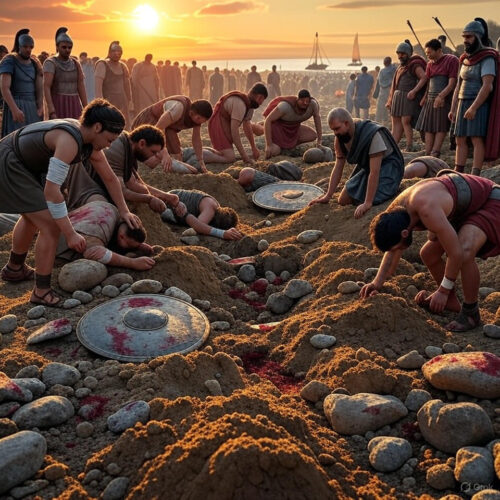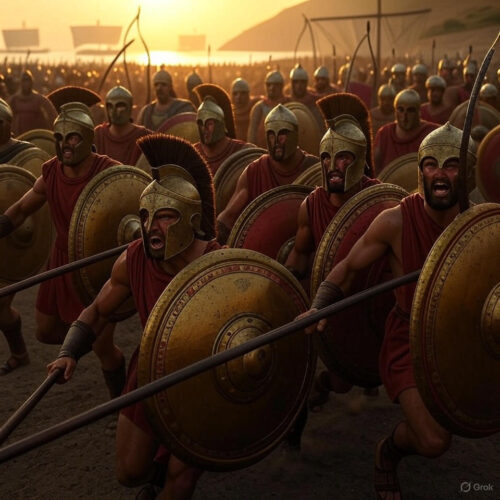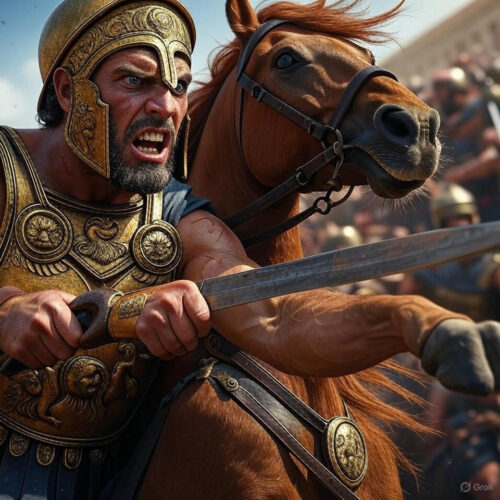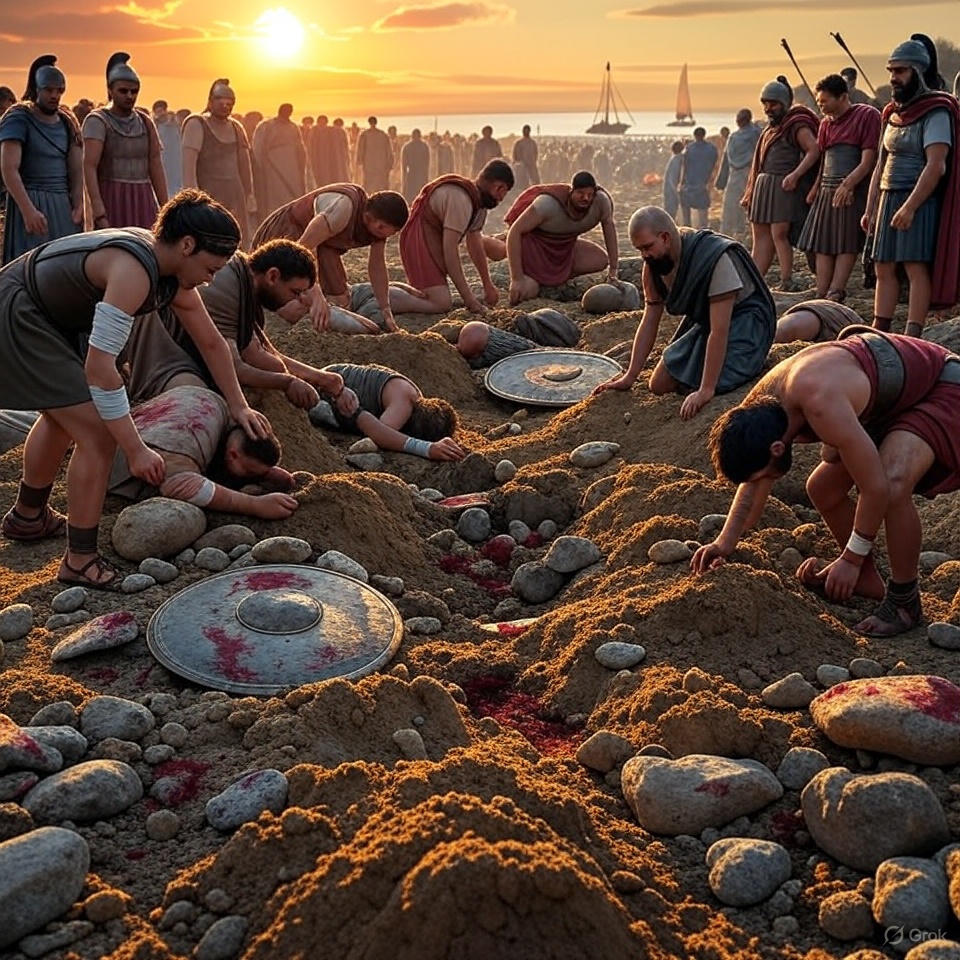Imagine a dusty plain under a relentless Greek sun, where the fate of Western civilization hung on the edge of bronze-tipped spears and the grit of ordinary men turned warriors. On September 12, 490 BC, the Battle of Marathon unfolded—a pivotal clash between the outnumbered Athenians and Plataeans against the mighty Persian Empire. This wasn’t just a skirmish; it was a defiant roar against empire-building tyranny, a moment that rippled through millennia, shaping democracies, inspiring legends, and even birthing the modern marathon race. In this blog, we’ll dive deep into the gritty details of that fateful day, exploring the political intrigue, tactical brilliance, and human drama that made it legendary. And because history isn’t just dusty tomes but a living playbook, we’ll unpack how the lessons from Marathon can ignite your daily grind, turning ancient strategy into personal superpower. Buckle up—this tale of heroism will leave you informed, inspired, and ready to charge your own battles.
To set the stage, we must rewind to the turbulent world of the late 6th century BC. The Persian Empire, under King Darius I, was a colossus stretching from the Indus River to the Mediterranean, a bureaucratic behemoth fueled by satraps (governors) who squeezed tribute from conquered lands. Darius, who ascended in 522 BC after a coup against a pretender named Gaumata, was no mere warlord; he was a visionary administrator who standardized weights, measures, and coinage across his realm. His empire boasted an army of immortals—elite guards said to be unkillable in battle—and a navy that dominated the seas. But hubris simmered. In 499 BC, the Ionian Revolt erupted, a rebellion by Greek city-states in Asia Minor (modern Turkey) against Persian overlords. Athens and Eretria, feeling kinship with these Ionians, sent ships and men to aid the uprising, burning the Persian regional capital of Sardis in 498 BC. This act of defiance was a spark; Darius vowed revenge, pinning a servant to remind him nightly: “Master, remember the Athenians.”
The revolt fizzled by 494 BC, crushed at the Battle of Lade where Persian ships outmaneuvered the Greek fleet. But Darius didn’t forget. He dispatched envoys to Greek city-states demanding earth and water—symbols of submission. Most complied, but Athens hurled the envoys into a pit, and Sparta tossed theirs into a well. War was inevitable. In 492 BC, a Persian fleet under Mardonius attempted invasion but was wrecked by storms off Mount Athos. Undeterred, Darius tried again in 490 BC, entrusting the task to Datis, a Mede, and Artaphernes, nephew of the king. Their force: 20,000 to 25,000 infantry, including archers, cavalry, and hoplites from subject nations like Carians and Ionians, plus a fleet of 600 ships. They first sacked Eretria on Euboea, enslaving its people, then sailed for Attica, landing at Marathon Bay on September 9, 490 BC.
Marathon was no random choice. The plain, about 26 miles northeast of Athens, was a flat expanse ideal for Persian cavalry and archery—Greek weaknesses. Bordered by swamps and hills, it funneled invaders away from the rugged terrain where Athenian phalanxes thrived. The Persians anchored their ships in the bay, disembarking troops under a fortified camp. Hippias, the exiled Athenian tyrant ousted in 510 BC, guided them, hoping to reclaim his throne. He was aging, bitter, and saw this as his last shot.
Athens, a burgeoning democracy since Cleisthenes’ reforms in 508 BC, mobilized swiftly. The Assembly voted for war, sending 10,000 hoplites—citizen-soldiers, not professionals—plus 1,000 from Plataea, their loyal ally. No slaves or mercenaries; these were farmers, potters, and traders clutching eight-foot spears (dory), short swords (xiphos), and round shields (aspis) in a tight phalanx formation. Command fell to ten strategoi (generals), elected annually, including Miltiades, a defector from Persian service with intimate knowledge of their tactics. Miltiades had ruled the Thracian Chersonese for Darius but fled after offending him, bringing strategic gold to Athens.
The Athenians marched to Marathon in two days, arriving September 10. They camped on the Herakleion Hill overlooking the plain, a sacred site to Hercules, positioning to block the main road to Athens. Pheidippides, the hemerodromos (day-runner), sprinted to Sparta for aid—150 miles round trip in two days—but the Spartans, mid-Carnian festival, delayed. With Persians looting farms and probing defenses, tension mounted. Skirmishes flared: Greek scouts clashed with Persian foragers, and a Plataean captain named Echetlaeus supposedly slew foes with divine aid, vanishing after.
By September 11, the Greeks held a defensive line across the plain’s narrowest point, about a mile wide, their phalanx 16 ranks deep in the center, thinner on wings. Persians, confident in numbers, waited for cavalry (perhaps offloaded or delayed). Miltiades, yielding his day of command to Aristides the Just, proposed attack. Debate raged: some favored retreat to Athens, fearing encirclement; others, like Miltiades, argued delay meant death—Persians could sail directly to the undefended city. Miltiades won, convincing the strategoi to unite votes.
Dawn broke on September 12, 490 BC. Trumpets blared. The Greek phalanx advanced at a walk, shields locked, to negate Persian arrows. Halfway, they charged— a mile in full sprint, shields rattling, spears leveled. Persians, caught breakfasting, scrambled. Their center buckled under the Athenian assault, but wings held, threatening to envelop. Miltiades’ genius: weaken the center deliberately, drawing Persians in, then smash flanks with reserves. The Greek wings, bolstered by Plataeans on the right, executed a double envelopment—the first recorded pincer movement. Persian archers loosed volleys, felling hundreds, but hoplite momentum was unstoppable. Close-quarters melee ensued: spears thrusting, swords slashing, dust choking the air.
The battle raged four hours. Persians fled to ships, but Greeks pursued, slaying stragglers. A desperate Persian counter—some say 4,000 archers reformed—failed. Athenians captured seven ships, but most Persians escaped by sea, heading for Athens. Miltiades dispatched Pheidippides again: the runner dashed 26 miles to the city, gasping “We have won!” before collapsing—legend says he died, birthing the marathon myth. Athenians, forewarned, rushed back, arriving just as Persians beached at Phaleron Bay, forcing retreat.
Casualties: Herodotus claims 6,400 Persians dead, 192 Greeks. The tumulus at Marathon, excavated in 1890, covers 192 cremations. Victory altars were erected; the Parthenon frieze later depicted it. Politically, it boosted Athens’ prestige, funding the Delian League, leading to the Golden Age under Pericles. Themistocles pushed naval reforms, averting disaster at Salamis in 480 BC. Without Marathon, Persian domination might have stifled Greek philosophy, drama, and science.
Delving deeper into the human element, consider the warriors. Miltiades, scarred by Persian intrigue, orchestrated from the front. Callimachus, the polemarch (war leader), fell spear-pierced, his vote tipping the scales. Plataean allies, fewer in number, held the right flank against elite Persian Immortals—perhaps the Cissian regiment. Persian side: Datis, poet-turned-general, lamented the loss in lost hymns. Hippias, sneering at democracy, watched his dreams shatter. The terrain played king: soggy marshes trapped Persian chariots (if any), and the Soros mound, built post-battle, stands today, a grassy sentinel.
Archaeology illuminates: Pottery shards from the site match Ionian Greek styles, confirming allies fought. Inscriptions praise the dead: “The men who once at Marathon… laid low the mighty Persian host.” Thucydides later critiqued the numbers but affirmed the rout. Aeschylus, veteran of Marathon and Salamis, immortalized it in “The Persians,” boasting on his tomb: “Of his glorious deeds, the most famous is this: at Marathon he and his fellow citizens by their valor saved Greece.”
The battle’s tactics influenced warfare. The phalanx charge, blending discipline and fury, echoed in Alexander’s conquests. Persian overconfidence—dismissing Greeks as “wooden-walled” foes—hubris undid them. Logistically, Greek unity trumped Persian diversity; hoplites, motivated by homeland, outfought conscripts.
Post-battle, Athens honored heroes. Miltiades’ ostracism in 489 BC for unrelated crimes shows democracy’s checks. The victory cult grew: annual races from Marathon to Athens began in antiquity, formalized in 1896 Olympics by Pierre de Coubertin, linking past to present.
Now, shifting gears, the thunder of Marathon wasn’t just echoes in history books—its outcomes pulse with relevance today. The Greek triumph preserved the cradle of democracy, proving outnumbered underdogs can topple giants through strategy, unity, and resolve. In your life, this translates to leveraging smarts over brute force, turning personal “plains” of challenge into victories. Here’s how to apply Marathon’s lessons specifically, with bullet points honing in on actionable insights, followed by a step-by-step plan to integrate them.
– **Embrace the Underdog Sprint**: Just as the Athenians charged unexpectedly, identify moments in your routine where waiting plays to your disadvantage—like procrastinating on a project deadline. Benefit: By initiating action swiftly, you disrupt inertia, gaining momentum that compounds into confidence. For instance, if facing a career hurdle, outline your “charge” by listing three immediate steps, mirroring Miltiades’ bold advance, to outpace competitors.
– **Strengthen Your Flanks with Alliances**: Plataea’s aid was crucial; isolate yourself, and vulnerabilities expose. In modern terms, build a network of mentors or peers for support during tough times, like job hunts or skill-building. Benefit: Shared wisdom amplifies your strengths, reducing isolation’s drag—studies show networked individuals advance 20% faster in careers. Apply by scheduling weekly check-ins with one ally, turning solo battles into collaborative wins.
– **Master the Pincer Tactic in Problem-Solving**: Miltiades weakened the center to envelop flanks; apply this to conflicts, like negotiating a raise by conceding minor points to highlight strengths. Benefit: It fosters creative resolutions, avoiding all-out wars that drain energy. In daily life, when overwhelmed by tasks, prioritize “flanks” (high-impact quick wins) over the “center” (daunting core), boosting productivity by 30% as per time management research.
– **Run the Messenger Relay for Endurance**: Pheidippides’ grueling run symbolizes pushing limits; cultivate physical resilience through consistent exercise, like interval training mimicking the charge. Benefit: Enhanced stamina spills into mental fortitude, combating burnout—regular runners report 25% higher resilience scores. Start with a 5K goal, visualizing the 26-mile legacy to fuel persistence.
– **Honor the Aftermath with Reflection**: Athenians built mounds for the fallen; after victories, pause to commemorate growth. Benefit: This cements habits, preventing regression—journaling post-achievement doubles retention of lessons. Use it post-project to note what “Persians” (obstacles) fell, reinforcing a winner’s mindset.
To operationalize this, here’s a 30-day Marathon Mastery Plan:
- **Days 1-7: Scout the Plain** – Assess your “Marathon” (a key goal, e.g., fitness or career shift). Journal background like Darius’ grudge: What past “revolts” (setbacks) fuel you? Research tactics via books on ancient Greece.
- **Days 8-14: Assemble the Phalanx** – Rally allies; contact three supporters. Train physically: Walk 10,000 steps daily, building to sprints, evoking the charge.
- **Days 15-21: Execute the Charge** – Attack your goal with Miltiades’ strategy. Break it into flanks/center; act daily, tracking progress without delay.
- **Days 22-28: Envelop and Pursue** – Adapt as needed; if resistance hits, pincer with alternatives. Run a 5K or symbolic distance, celebrating the “victory cry.”
- **Days 29-30: Build the Tumulus** – Reflect: What endured? Plan next “invasion” defense. Maintain alliances; repeat quarterly for sustained momentum.
This plan isn’t abstract—it’s your personal Battle of Marathon, transforming history’s fire into life’s forge. The ancients ran for freedom; you can run for fulfillment.

